![[California flag]](../images/u/us-ca-firstbear.gif)
![[California flag]](../images/u/us-ca-todd.gif)
original image from James J. Ferrigan III, 27 June, 2014 - image by Pete Loeser, 20 July 2014

Last modified: 2025-10-11 by rick wyatt
Keywords: california | bear | todd | revere |
Links: FOTW homepage |
search |
disclaimer and copyright |
write us |
mirrors
See also:
In 1996, California began the celebration of the Sesquicentennial of Statehood with event #0001, the Raising of the Bear Flag, in Sonoma. This was the first in a series of celebrations which commemorated the events which ultimately lead to Statehood for California.
As a part of those celebrations a web page was created, and as part of that I was asked to aide in identifying the various the various known 1846 California Bear Flags. This list brief list included all the flags which survived into the era of photography, The Todd Flag, The Storm Flag, and the Revere Guidon.
We also included those flags which could be logically reconstructed from either drawings or descriptions. Also shown is the McChristian flag, and although probably post 1846, it is the only surviving flag associated with one of the 33 "Bear Flaggers." More definitive work on the subject is in progress, with plans to present it in the year 2000.
James J. Ferrigan III, 3 October 1998
![[California flag]](../images/u/us-ca-firstbear.gif)
![[California flag]](../images/u/us-ca-todd.gif)
original image from James J. Ferrigan III, 27 June, 2014 - image by Pete Loeser, 20 July 2014
The flag we commonly refer to as the "original" Bear Flag may not be it. It seems that the commonly accepted flag is, in fact, not the first so-called Bear Flag as is commonly believed. According documents in the California Society of Pioneers the Todd flag was not made until the 17th or 18th of June. It is quite possible that NO Flag was made on the 14th, at least before Eziekiel Merrit departed with Lt. Col. Vallejo for Sutter's Fort. Instead another flag may have the honor of being the first Bear Flag. What we do know about the Todd flag is that it was the last flag of the California Republic, but it may not be the first. It would also seem that many California Republic flags were made in not only Sonoma, but in other locals as well. between 14 June and 9 July 1846.
James J. Ferrigan III, 6 July 2001
It was in 1846 in the town of Sonoma that William B. Ide was named the "Commander"" of the Bear Flag Revolt. Which Sonoma flag was the first flag of the short-lived California Republic is unclear, but we do know is that this was officially the "last" flag of the California Republic. It was created by William Todd, a nephew of Mary Todd, the wife of Abraham Lincoln. Todd never claimed his was the first Bear Flag, or the only one.
In a letter to Archibald Gillespie, later printed in the Los Angeles Express, Todd stated that the star and bear on his flag were painted using red paint and "vineberry" juice mixed with brick dust, which made for a faded-reddish tone. The wording was drawn in black India ink, including a period erroneously placed between the "I" and "C." This mistake allowed him to positively identify the flag years later for the Pioneer's Society. According to the Todd letter the bear was used as a symbol of strength and unyielding resistance. The red strip at the bottom of the flag was made of red flannel. It has been claimed that the use of the red colored star was to recognize the earlier California Lone Star Republic Flag, but this is unsubstantiated.
After being replaced with an American flag in Sonoma, the Todd Flag was taken back to the Washington Naval Yard for a time, but was returned to San Francisco in 1855 where it was given to the Society of California Pioneers. This original Todd Flag was lost in the fires that followed the great San Francisco earthquake, but not before an 1896 copy of the flag was made that still exists and is on display at the Sonoma State Historical Park Barracks Museum.
Pete Loeser, 20 July 2014

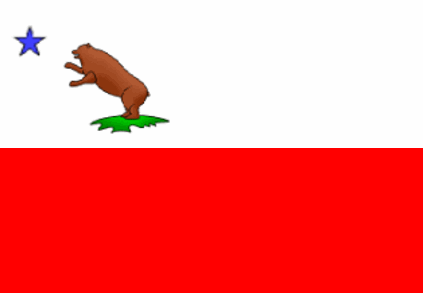
original image from California Bear Flag Museum - image by Eugene Ipavec, 20 July 2014
Local Tradition says this flag was sewn by Peter Storm on the evening of June 13, 1846. Storm was a saddle maker and local legend says that since he was skilled with a needle, he crafted this flag for the Bear Flag Party (or American Party) the night before he joined it as they moved up the Napa Valley on their way to Sonoma. According to his wife's contemporary account, he used four diapers cloths she had just cut and dyed, two red and two white, to make the two stripes on the flag before he sewed his bear emblem on to the white portion. Later, Vallejo's brother would say he thought emblem on the flag was a pig. Anyway, if accurate, this flag would have been carried with the "Bear Flaggers" as they descended on Sonoma on the morning of June 14, 1846, and would predate the Todd flag by days. It also may have been the model that influenced the design of the more well-known Todd flag for the Bear Flag Republic.
Until his death in the 1870s Peter Storm, who also reportedly helped Todd with his flag, was locally accepted as having made the first Bear Flag. A period photos exist of Storm holding either his original flag or a replica during a celebration in Napa in 1873, but sadly, since he chose to be buried with his flag in Calistoga, it is lost to history.
Pete Loeser, 20 July 2014
See also: Extended discussion about the Storm bear flag
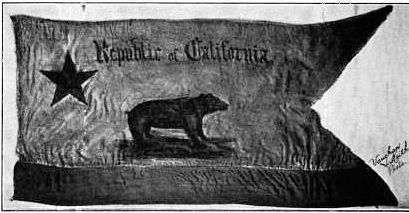

original image from James J. Ferrigan III - image by Eugene Ipavec, 20 July 2014
This is the guidon of the Grigsby Company, later named Company E, one of the eight companies of the California Battalion. Grigsby's Company was originally one of four organized in the first hectic days of the California revolt in Sonoma. At first called Company B, it was later federalized by Commodore Robert Stockton into Company E, 1st California Volunteer Militia and U.S. Mounted Rifles. Made of silk, and small enough to be carried by mounted troops, this guidon is thought to have remained with Captain John Grigsby and his company when they were left to defend Sonoma as the rest of the newly federalized California Battalion went south under the command of John C. Frémont. Frémont had been promoted to major by Commodore Stockton, and given command of all Volunteer Militia in California.
Confusion exists, but somehow this guidon was left behind in Sonoma when Grigsby and his men left. Reportedly the guidon was removed from the Sonoma barracks by US Naval Lieutenant Joseph Warren Revere, Paul Revere's grandson, and kept as a souvenir. Revere later said he took the guidon back to his home to Morristown, New Jersey. Later, during the Civil War, Joseph Revere, now a General, according to one account, showed the guidon to General William T. Sherman. Sherman suggested that it be returned to California. After the Civil War, Revere apparently followed his advice, and sent it to the California Pioneer's Society in San Francisco with a letter explaining how it came into his hands. The guidon was, unfortunately, later destroyed, along with the Todd Flag, in the San Francisco Earthquake and Fire of 1906.
Pete Loeser, 20 July 2014
I'd like to add some further information on the Revere or California Battalion Guidon after discussing it with Jim Ferrigan and then Bill Twinkle of the California Bear Flag Museum. They feel, and I agree, that one of the problem's with the Grigsby Guidon is that many people combine historical information about two different incarnations of a military unit called the "California Battalion,"" both under the command of Grigsby at various times.
The first incarnation of the California Battalion was the unit created in Sonoma on July 5, 1846. This unit was created from the existing Bear Flag Party, Frémont's men and additional volunteers that had swelled their ranks since the events of June 14. This first incarnation of the California Battalion selected John C. Frémont as their Commander-in Chief. He appointed a serving United States Marine Corps officer, Captain Archibald H. Gillespie as his Adjutant.
These first companies elected their own officers. The four companies chose Henry L. Ford, John Grigsby, Richard Owens, and Granville P. Swift. The companies were usually identified by their captain's last name, a common conceit in the 19th century. However in this first incarnation of the California Battalion, Grigsby's company was identified as the "B" Company, and was the unit that remained as the guard in Sonoma when Frémont departed with A, C & D companies.
Frémont and the California Battalion eventually arrived in Monterey, and on July 23, 1846, they were mustered into federal service by Commodore Stockton. This second incarnation of the California Battalion (1st California Volunteer Militia and U.S. Mounted Rifles) was reorganized into eight companies, plus artillery. Herein lays the confusion - Grigsby will not rejoin the battalion until later that summer and by that time it was re-designated as company "E"; however, by that time all reference to the "Republic of California" was moot and the guidon, wherever it was located, obsolete. This is the California Battalion's incarnation that is usually identified by historians (including Wikipedia) who either ignore or are ignorant of its origins in Sonoma.
As for how Revere ended up with the guidon, one must remember that he had various duties in and around Sonoma and could have removed the guidon at any time during these activities.
Jim's assumption has always been that the four original California Battalion companies' guidons were made in Sonoma. This is only his opinion and he admits that he has never had a chance to do further research. He bases this opinion on time he spent in Sonoma, and conversations with Bob Parmalee and the historians at Sonoma State Historic Park. I believe he is most likely correct about it however.
We both believe there were other guidons for the other companies, and they were likely acquired and fabricated later in Monterey, but the point is moot, they are now all lost. Also the Battalion most likely acquired a standard in Monterey, but again the location or documentation not known.
Because of this, Jim feels it would be best to only identify this remaining flag as the Grigsby Guidon or the Reveres Guidon, and leave it at that until more evidence comes to light. Jim has also checked and found that General Revere was a brigade commander and did not serve with Sherman directly during the Civil War. Their only common connection was their service in California, so it would be best to treat the story of Sherman influencing Revere to return the flag with suspicion.
Pete Loeser, 29 July 2014
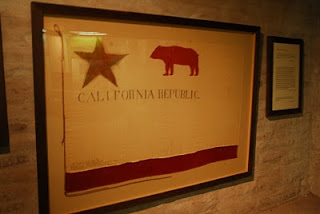
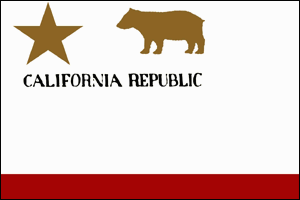
original photo from Pete Loeser, 20 July 2014 - image by Devin Cook, 28 December 2004
For many years, members of the California Society of Pioneers would carry the original Bear Flag during Admission Day parades and also on anniversaries of the Bear Flag Revolt. A duplicate of the original Todd Bear Flag was made in 1896, the 50th Anniversary of the Bear Flag Revolt, and displayed in Sonoma. As a result of the Great San Francisco Earthquake and fires the original Todd flag was destroyed in the the Society's Pioneer Hall, but the 1896 copy survived. This duplicate flag continues to be displayed at the Sonoma Barracks. Because of the fading of the reddish-orange star and bear on the Semi-Centennial replica, they appear to be colored in a slightly different almost goldish color in the dim museum light, which may explain the many replicas sold today.
Pete Loeser, 20 July 2014
There are several additional Bear Flags that were reportedly made in Sonoma and elsewhere during this period, and while none are known to have survived, we are indebted to Hubert Howe Bancroft for his pioneering History of California, where he preserved these descriptions for posterity. They were first brought to light by Harry Knill of Santa Barbara on whose work these illustrations are based.
Pete Loeser, 23 December 2014

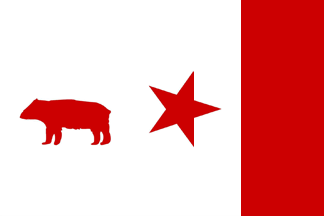
Photo: Huntington Library, Art Collection - Speculative image by Clay Moss, 23 December 2014
Pío Pico was the last Mexican Governor of Alta California. This Bear Flag design, which appears as an illustration at the bottom of the Spanish language version of California's Proclamation of Independence made for Pío Pico, was probably never made into a cloth flag. Whether the image was used to officiate the document in the absence of a seal, or to simply inform Pío Pico of what the flag looked like is unknown. It is the only version of the Bear Flag depicted with a vertical stripe.
Pete Loeser, 23 December 2014
 image by Clay Moss, 4 January 2015
image by Clay Moss, 4 January 2015
William Brown Ide was the Commander of the short-lived California Republic. His flag was designed by Captain Henry Ford of Company B of the California Battalion. Its design is reminiscent of both the Todd and Storm flags.
Pete Loeser, 23 December 2014
 image by Clay Moss, 4 January 2015
image by Clay Moss, 4 January 2015
Captain William Swasey was a member of the California Battalion, he participated in and observed many of the key events of the Mexican-American War in California, and later wrote of them in his Early Days and Men of California, published in 1896. The red, white, and blue stripes were probably inspired by the American flag. This flag is based on a description in Bancroft's History of California published in 1886.
Pete Loeser, 23 December 2014
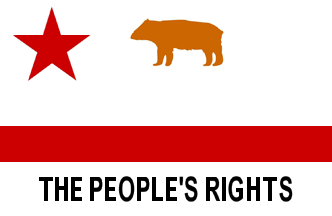 image from Clay Moss, 23 December 2004
image from Clay Moss, 23 December 2004
Dr. Robert Baylor Semple founded the town of Benicia in 1847. The Semple flag is based upon a written description, since the original flag has not survived. Dr. Semple was one of the group of men who arrested, paroled and re-arrested General Vallejo during the hectic days of the establishment of the short lived "Bear Flag Republic." Dr. Semple is also credited with having prevented the expedition from looting Sonoma, stating that they had come there for a "more noble purpose."
Pete Loeser, 23 December 2014

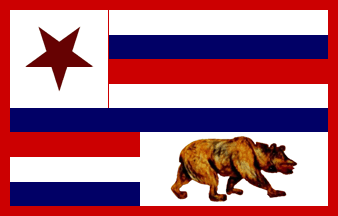
photo from James J. Ferrigan III - image by Clay Moss, 23 December 2014
This carefully made flag, now in a private collection, is the only surviving flag known to have belonged to a "Bear Flagger." The meticulous design combines elements of both the Bear Flag and the Stars and Stripes. The style of the bear, because of its remarkable similarity to a famous painting of a California grizzly done by Charles Nahl in 1850, probably indicates the flag was made after this date. Nevertheless, it is one of the oldest surviving Bear Flags and the only known flag with an association to a member of the Bear Flag party. James McChristian was the last Bear Flagger to die, on June 22, 1914, at 87 years of age in Sebastopol and is buried in the Sebastopol Cemetery. It was discovered among Patrick McChristian´s effects in the early 20th century (father and son). Currently, the McChristian Flag is rumored to be on display at a local winery according to Jim Ferrigan.
Pete Loeser, 23 December 2014


Purported flag from James J. Ferrigan III - Speculative image by Clay Moss, 4 January 2015
Between 1992 and 1995 The Flag Store in Sonoma, CA owned principally by Mr. John Tuteur, formerly owner of the Paramount Flag Co. of San Francisco, CA and managed by me, undertook a research project to replicate and offer for sale a line of the historic bear flags of California. To that end we began to compile information, images and where possible, photographs of the flags appropriate to the short lived Bear Flag Republic.
We were subscribers to the comprehensive flag research service of Dr. Whitney Smith's Flag Research Center (FRC). We asked Whitney for images of the various known California bear flags. Among the images sent from the FRC was a line drawing of the purported "Bettmann Archive" flag in question, with hatchings shading the four stripes. There was no explanation accompanying the flag. Since this flag was unknown to us I asked Whitney for more information, but none was forthcoming, as it had been acquired from one of the many clipping services Whitney utilized.
The flag was, is and remains a curiosity. When the time came to decide which flags to carry in the store, we, John and I and the store manager from the gift shop on the Sonoma Barracks, decided to include it, mostly because it was a curiosity. It was displayed during some of the events celebrating the Sesquicentennial of the Raising of the Bear Flag in the Sonoma Plaza during the summer of 1996.
The flag is a reconstruction from the line drawing, not a photograph of an actual flag. For the bear we chose to use a modern bear from a commercially produced California state flag, rather than the silhouette of an 1846 bear so it would be recognizable as a reconstruction, so there would be no mistaking it in later years for an antique. The stripes were reconstructed from the hatchings. The design and placement of the star and bear was based on the drawing.
When I searched the Corbis website for Pete Loeser I could not locate this drawing, so I called customer service and explained the problem. The explained that if it did not come up in their search engine under California or bear or any of the other combinations I tried that I would need a title, a number, a tagline or some more specific way to relocate this image.
I left the store in 1997 after it was sold to a new owner. The original correspondence was in their files when I left to move to Nevada. I gave this information to Pete, and he posted it on the FOTW site as UFE15-2 on 7 January 2015.
When Pete contacted me I sent him images of most of the flag we reproduced for the 1996 Sesquicentennial. Frankly I'd forgotten about the flag until I opened my box of Bear flags to photograph them for Pete. Perhaps a half-dozen of these were made, and the photograph is of an example I retained.
Jim Ferrigan, 14 January 2015